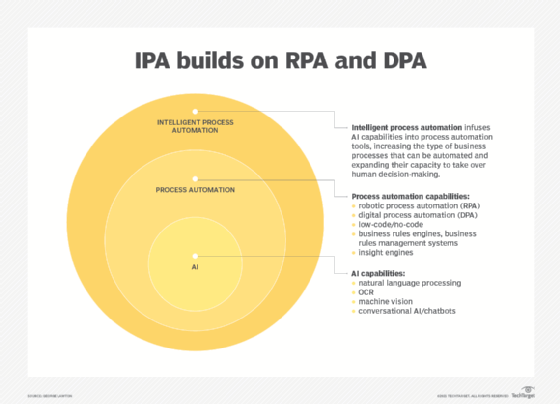intelligent process automation (IPA)
What is intelligent process automation (IPA)?
Intelligent process automation (IPA) is a combination of technologies used to manage and automate digital processes. IPA should increase operational efficiency, worker performance and response efficiency to customers. They should also reduce operational risk with the goal of creating an effective operations environment.
IPA is designed to assist human workers by doing manual, repetitive and routine tasks that were previously performed by humans. Technologies combined in IPA include robotic process automation (RPA), artificial intelligence (AI), machine learning (ML) and digital process automation (DPA). With these technologies -- especially with AI and machine learning -- an IPA tool should be able to learn how to adjust and improve the process flow to create an intelligent process. It should be able to learn and improve over time.
IPA is important in automating more and larger portions of enterprise jobs. IPA enables users to more quickly and easily scale up their automation use cases and carry out more sophisticated tasks, such as automatically detecting objects on a screen or using technologies like natural language processing (NLP).
What makes up IPA?
Understanding what IPA is and what it can do starts with what technologies are used to make it possible. The following four technologies are included:
- AI. AI is the simulation of human intelligence processes by machines, especially computer systems. AI can analyze data faster than humans could, while recognizing patterns and learning from past choices.
- ML. ML is a type of AI that allows software applications to become more accurate at predicting outcomes. Machine learning algorithms use historical data as input to predict new output values.
- RPA. RPA is a software automation tool that can help in automating labor-intensive tasks. It can perform rule-based tasks and typically includes AI and ML.
- DPA. DPA is software used to automate tasks with the goal of completing and optimizing a workflow. DPA automates, or partially automates, tasks that typically need human interaction.
Other technologies found in IPA tools may include NLP tools or cognitive agents. Through combining all these technologies, an enterprise can automate labor-intensive tasks while still being adaptable to change.

RPA vs. IPA: What's the difference?
IPA and RPA are similar processes. However, IPA can cover a larger scope of work than RPA. RPA is generally meant to be used for defined, rule-based processes. Comparatively, IPA is used for more complex operations that benefit from the use of AI, ML, NLP, predictive analytics and other technologies including RPA.
IPA can also handle more types of data formats, as well as enable more types of intelligent decision-making. Both IPA and RPA are valuable and have their own best use cases. However, IPA first requires the foundation of RPA. In addition, an effective IPA strategy requires IT and data science teams to collaborate more in-depth than is necessary with RPA.
IPA is also a similar term to business process automation (BPA), which can be used as another analogous term.
Benefits of IPA
The benefits of using IPA include the following:
- Automation of previously manual and repetitive tasks.
- Optimization of worker productivity by freeing them of routine tasks.
- Coordination of work between software systems and people.
- End-to-end visibility of processes and customer journeys.
- Improvement of customer experience.
- Reduction of processing errors.
- Decreasing of operational costs and transaction processing time.
- Easier adaptation to changes in process.
Current and future use cases
Because IPA and RPA are similar in nature, as soon as an organization has a stable RPA environment, they can extend that environment with IPA -- using the previous environment as a foundation. Using IPA, organizations can replace previously manual and repetitive tasks, interpret text with NLP, make machine-based decisions with machine learning, provide tracking for systems and people and offer customers suggestions using cognitive agents.
In the past, there was more of an argument to be made about whether an organization should use IPA versus RPA. Now, however, it's accepted that organizations could use IPA to cast a broader strategy around RPA. Rather than having all the technologies involved with IPA deployed individually, an IPA tool can tie them together to form more agile and stable business operations.
An example IPA use case would be when an organization needs to gather data for a customer that would normally take up a large amount of time. An IPA tool could interpret the needed text and make decisions on how to share that data, then offer suggestions to the customer based on their input.
Market outlook and leading tools
According to a 2019 global robotics survey by Deloitte, executives estimate that intelligent automation will provide an average cost reduction of 21% and an increase in revenue of 9% over the next few years.
IPA is becoming more popular as a growing number of vendors begin offering more IPA products and workflow automation tools. Some IPA, or intelligent RPA products, include the following:
- Another Monday. This automation platform automatically documents process logic, pulls tasks from a database and offers a drag-and-drop user interface.
- UiPath. This RPA tool supports IPA features. It can automate any desktop or web app.
- Automation anywhere. This RPA tool has begun to embrace IPA qualities. It combines RPA with language understanding and the ability to read unstructured data.





